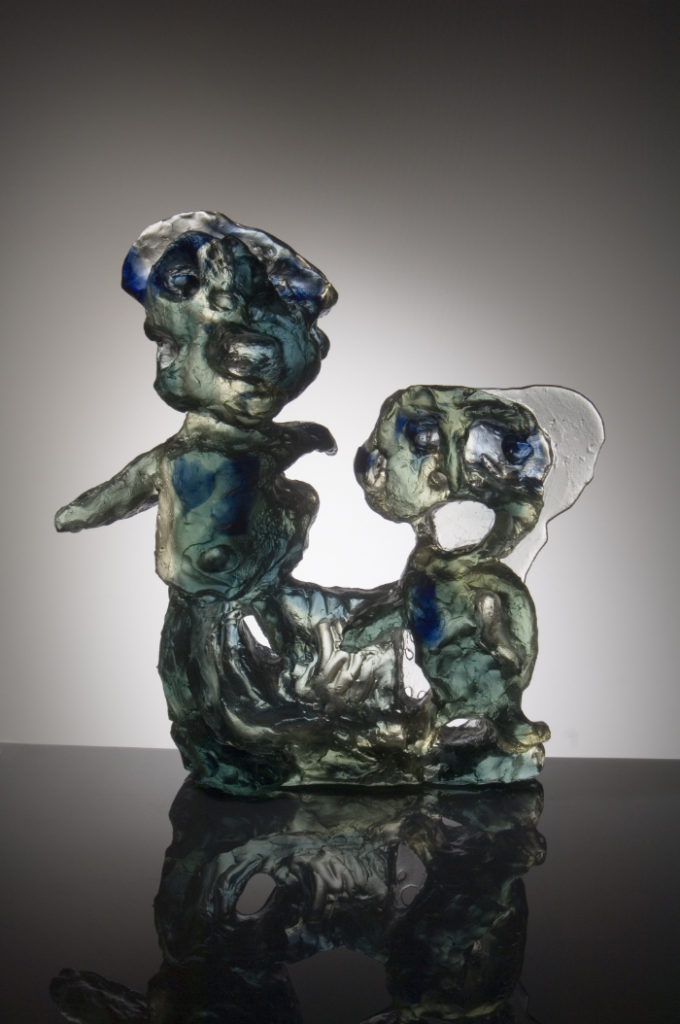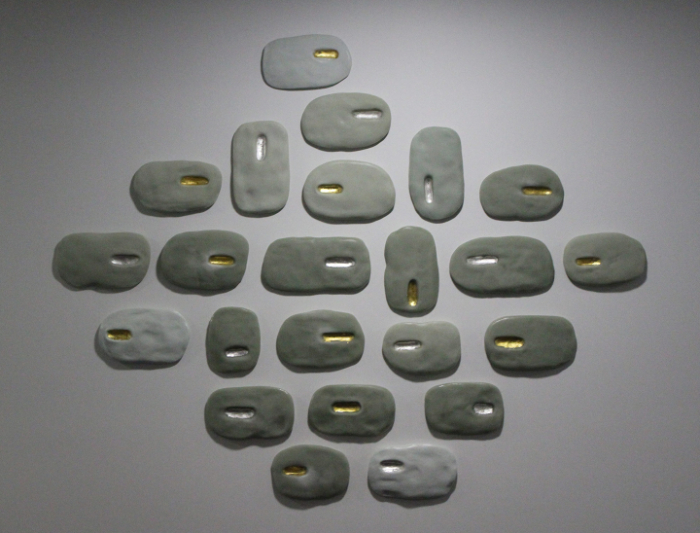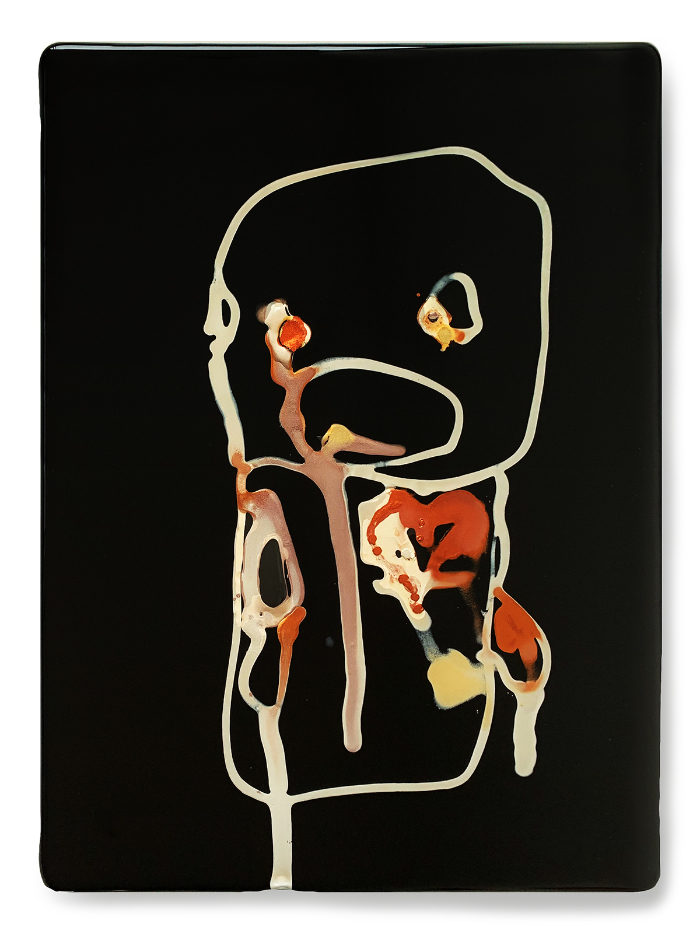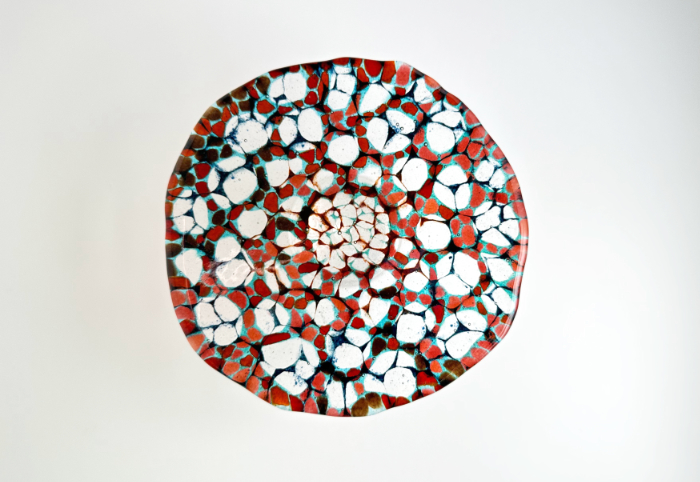
Out of the margins
Australian glass artist Emma Borland has an interest in naïve and outsider art, with a lot of her work focused on representing the marginalised. Linda Banks finds out more.
What led you to start working with glass?
I began working with glass in a lead lighting studio in Melbourne when I first left school. At the studio we recycled the original English Muffle glass and restored old stained glass windows. This experience really inspired my ongoing love and deep appreciation of glass as a unique material.
What glass techniques have you used, and which do you prefer?
I have used most glass techniques at some time or another. After my initial experience with stained glass, I travelled to England and spent a short time assisting Peter Hewlett with his Bristol blue glass. Following his recommendation, I attended Dudley College in Brierley Hill. There, I was introduced to glass blowing, glass casting, coldworking, fusing and slumping, design, and history. Then, during my master’s degree at Monash University in Melbourne, I investigated casting sculptures with industrial glass. Currently, I am particularly enthusiastic about the simplicity of fusing glass, combining rich, sumptuous colours and applying my glass cutting skills from the early leadlight days to fuse glass wall panels.

What is your creative approach? Do you draw your ideas out or dive straight in with the materials?
Often, I will sketch out my designs and draw ideas into my studio diary. I also love developing ideas using collage. For my current exhibition I spent time at the photocopier enlarging forms and reducing their scale to make sure the final composition was balanced. I also spend a lot of my time experimenting with different shapes and selecting the colours that really work well together.


What inspires your work?
I find my inspiration in fine art, architecture, furniture, and fashion. I also find inspiration in Scandinavian design and the mid-century modern aesthetic revival.
I really enjoy the challenge of working out how I can realise my ideas in glass and make the best work that I can. I find it inspiring because it is not always easy.
Most importantly my inspiration is my family.

What message(s) do you want to convey through your art?
Through my work with glass, I am always considering the affective qualities of each shape, form and colour and their interrelationship. I contemplate the tension that appears in the spaces between the lines. Within this process I aim to convey a sense of peace and balance while developing a narrative that is expressed through the form. I aim to compose works that explore themes close to my current experiences. Underpinning all of this is the sense that I want to create art that will last. I have always believed that glass, clay, metal, timber, and stone hold the the same status as paint within fine art.

What is your favourite tool or piece of equipment and why?
I would not be able to go without my glass cutter, set squares or grozing pliers. These are my favourite and most often used tools. I use these all the time to cut out the forms and shapes from the sheets of glass. I guess I feel most confident with these because of my early days lead lighting, where I was required to used them all day to cut small, detailed pieces of glass.
There are also the grinders and small test kiln that I love and use frequently.

Do you have a favourite piece you have made? Why is it your favourite?
One of my favourite pieces is the Triptych (see image). It is one that I still love because of the figures and how they relate to each other in the three panels. For me, this piece summarises the importance of community and the strong need to accept each other unconditionally, regardless of race, belief or religion. The central figure is unsure, insecure and alone. The other figures in the piece appear to be gossiping and judging this lone person. I feel this piece illustrates the strength and vulnerability in people.

Where do you show and sell your work?
After many years of exhibiting without representation, I am now in the very fortunate position of exhibiting with Murray White Room here in Melbourne. Murray is an extraordinarily experienced gallerist, with an eye for detail. He really understands the cultural significance of the arts and their place in a historical context. For Murray, each piece is a precious object to be respected. Our partnership is based on mutual trust and longevity.

What advice would you give to someone starting out on a career in glass?
Keep going and persevere with your vision. Explore glass techniques and technology. Glassmaking is expensive, so enrol on a good course if you can so that you have access to like-minded people who you can collaborate with. In all the places I studied I met people from all over the world working in glass. The depth of skills and knowledge of these people was amazing for me. Each glassmaker had valuable experiences to share. There was also the added benefit of having access to maintained studio equipment. Look globally, think locally, and share your enthusiasm with others. Keep going no matter what – it’s the most important thing.
Do you have a career highlight?
Every time I get the chance to exhibit and show my work is a highlight. Sharing my love of art and glass with school-aged children is especially rewarding for me and explaining my studio process to my son’s class when he was little was a particularly special moment.

Where is your glass practice heading next?
I am planning to explore designing panels that incorporate plate glass, waterjet cutting, enamels, and mirroring techniques. I am also developing my sculptural work using glass, marble, metal and concrete.

Is the global energy crisis affecting your practice?
Yes, most definitely. We have a furnace that we cannot afford to run due to power costs. The price of importing sheet glass from America has increased considerably and I am always looking for ways to incorporate the best materials for the best price. My husband is also a glass maker and assists me with our studio practice. Together we are constantly looking for ways to reduce the costs associated and we regularly fire the kiln when the price of electricity is at its cheapest rate. I am fortunate to work full time as a special needs teacher, which is my other passion, in order to support my family and to continue pursuing my arts practice.
About the artist
Emma Borland is the youngest daughter of celebrated Australian modernist architect, the late Kevin Borland. Her early immersion in art and architecture is evidenced in her abstract ‘Colour Bank’ panels. Furthermore, these abstract works can be traced to her late mother, Margaret Borland’s, interest in Scandinavian jewellery, furniture and design.
The aesthetics of naïve and outsider art, l’Art Brut and Jean Dubuffet, have remained central influences on Borland’s art practice. Alongside her sister, artist/photographer Polly Borland, she shares an interest in psychology, vulnerability and the marginalised, which presents in both artists’ figurative images and subjects. This shared bond was highlighted in the two-person show Borland + Borland curated by Artistic Director Magda Keaney at Canberra Glassworks in 2015.
Borland holds an MA in Fine Art by Research (Glass), and a MA in Teaching, both from Monash University, Melbourne. She also undertook masterclasses under the late Klaus Moje AO at Canberra Glassworks.
She lives and works in outer Melbourne’s Dandenong Ranges.
See her current show here until 31 March 2023.
Visit her website here.
Main image: Emma Borland in her studio with one of her iconic abstract fused glass pieces. Photo: Mark Ammermann.

